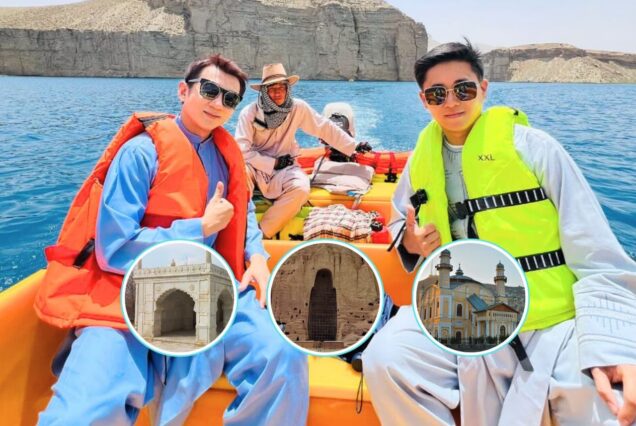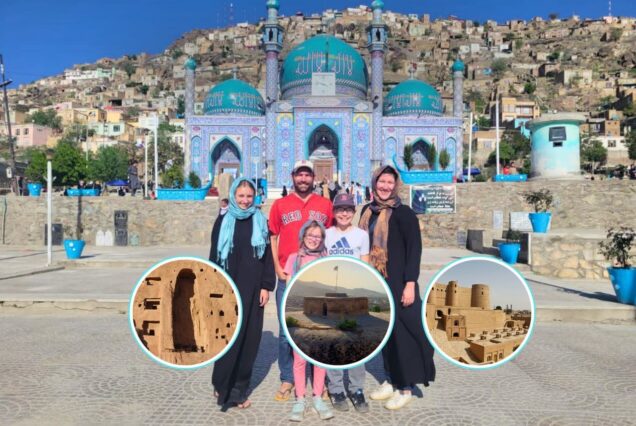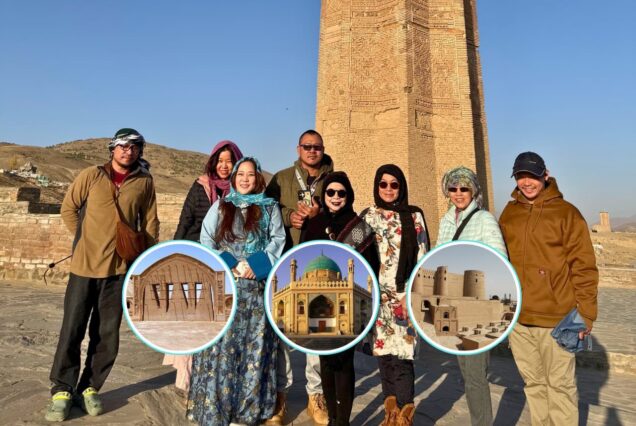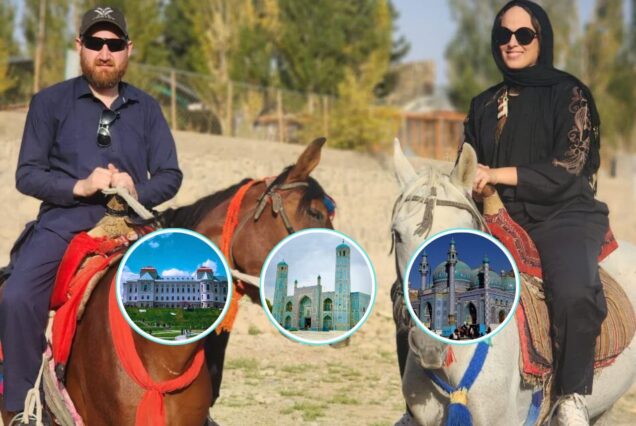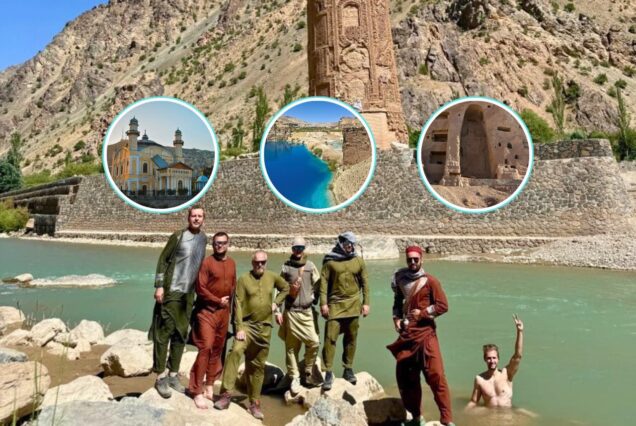(Kabul- Bamyan- Blue Lakes- Minaret of Jam- Herat- Kandahar- Samangan- Mazar e Sharif- Balkh District).
One person: 3400 USD, two people: 2600 USD/person and great discounts for groups.
The date is open and the tour is suitable for both individuals and group travelers.
Included/Excluded
- Invitation Letter
- Permit Costs and Taxes
- Pickup and Drop off at the Airport
- English-Speaking Tour Guide
- All Road Transportation
- All Accommodation
- All Site Entries
- All Meals (Breakfast, Lunch and Dinner)
- Bottled Water
- Sim Card and 10 GB Internet Package
- Visa Fee
- Flights
- Afghan Clothing
Tour Plan
Pick up by the tour guide and driver. Hotel check-in and a short briefing of the tour by the guide. Breakfast or lunch if needed.
Money exchange and going to a tailor shop for the local outfit/shirt.
Touring Kabul depending on what time remains:
First of all, we will take you to BiBi Mahroo hill (the big flag) to have a bird’s eye view of Kabul city.
Visiting the oldest market, Mandawi bazaar and the Bird market. Walking around Pul-e-Khishti Mosque (1793-1800), Nadir Pushtun Wat, Chahar Chatta bazaar and Pul-e-Bagh-e-Omumi to catch the atmosphere of Kabul.
Visiting Mandawi Bazaar in Kabul, is an experience as it is not only a market but an amazing insight into life here – you will find many street traders, butchers, bakeries, Banjara, fresh and dried fruits.
Visiting the Shah-Do-Shamshira Mosque (1544) relates to an early legend concerning the arrival of Islam in Kabul.
Breakfast, lunch and dinner
Accommodation: Khyber Hotel
This is a 4-hour beautiful drive, traveling through the fascinating Hajigak Pass (3700 m: 12,140 ft.), with stops at picturesque rest areas to refresh and take unforgettable photos.
Registration with the Provincial Afghan Tour Department.
Visiting the ruins of Buddha Statues (once tallest standing Buddhas in the world) UNISCO Heritage Sites, the Large Buddha, 55 m: 180 ft high (late 5th to the early 7th centuries A.D.). The Small Buddha, 38 m: 125 feet high (the 3rd or very early 4th centuries A.D.). Both were demolished by the Taliban in 2001.
Visiting the ruins of Gholghula City (The City of Screams), one of the eight UNISCO Heritage Sites in Bamyan. Build by Ghaznavids (977-1186) and demolished by Genghis Khan in 1221.
A visit to the ruins of Zuhak City (The Red City), UNISCO Heritage Sites. The fortress is believed to have been founded between 500-600 A.D. by the Hephthalites, around the same time as the Buddhas of Bamyan were created, demolished by Genghis Khan in 1221.
Breakfast, lunch and dinner
Accommodation: Bam-e-Asia Hotel
A full day hiking and sightseeing around Band-e-Amir Blue Lakes. Altitude: 2916 m: 9567 ft. There are five lakes in all. The largest lake, Band-e-Zulfiqar is four miles long and…
We will continue our drive to Yakawlang district to make the next day’s drive shorter.
Breakfast, lunch and dinner
Accommodation: A local guesthouse in Yakawlang district
This is an 8-hour drive from Yakawlang to Firuzkuh, the provincial capital of Ghur province.
Breakfast, lunch and dinner
Accommodation: Firuzkuh Palace Hotel
Minaret of Jam: the 213 foot: 65 meter ‘minaret’ stands alone on the south bank of the Hari Rud (Hari river) in a lonely, remote valley closely surrounded o all sides by towering barren mountains. Only the Qutb Minar in Delhi, directly inspired by the Jam minaret, stands higher, at 238 feet. The Minaret of Jam is, therefore, the second highest minaret in the world. More importantly, it is the only well-preserved architectural monument from the Ghorid period. The slender, tapering tower rises from an octagonal base 47 feet in diameter. It is constructed of fired brick. Winding around the designs of the first tier, passing from one panel to another, there is an epigraphic band containing the entire text of the 19th Sura of the Holi Qura’an, a long Sura entitled Maryam (Mary) which speaks of Mary and the Virgin Birth, of Prophets Abraham, Isaac, Jacob, Moses, Aaron, Ishmael and Enoch, and, of Adam and Noah.
We will leave Firuzkuh early for a 5-hour drive to the minaret.
Hiking and sightseeing around the minaret.
We will continue our drive to Chisht e Sharif district for a 7 hour drive.
Breakfast, lunch and dinner
Accommodation: a local guest house in Chist e Sharif
We will continue our drive to Herat for 8 hours.
Registration at the Provincial Afghan Tour department and hotel chick-in.
Breakfast, lunch and dinner
Accommodation: Sadaf Hotel
Visiting Masjid-e-Jami or Friday Mosque. The form in which it stands today was originally laid out on the site of an earlier 10th century mosque in the year 1200 by the Ghorid Sultan Ghiyasuddin (died 1202). Today’s restoration of the mosque continues a tradition of architectural decoration of Timurid (15th century).
There is a Madrasa (Islamic school) inside the mosque where students continue a tradition active in the mosque since the 10th century.
Visiting the Citadel of Alexander the Great 330 B.C. and built in its present form by the Kart Malik Fakhruddin in 1305 A.D. Genghis Khan and Amir Timur (Timuri Lang) fought beneath its walls and it was the heart of the Timurid Empire for a hundred years (1405-1506) after that fighting.
Walking around the old city of Herat. The four main bazaars of the old city come together at a center square called the Chahrsuq or Four Bazaar. In addition to the old shops lining the streets there are several covered bazaars in the vicinity. covered bazaars are now rarely to be seen outside of Herat and visitors are encouraged to include a visit to a a few of these bazaars.
You will visit the neighborhood of Jewish Afghans who were forced to leave their country years ago and their Synagogues and bath.
Visiting the Caravanserais located on Silk Road around Chahrsuq.
Visiting the Malan bridge 1100AD.
Visiting the Musallah Complex, designed and built (1417) under Queen Gawhar Shad, wife of Shah Rukh, son of Amir Taimur (Taimur Lang), artistic director. Most of these great works of art were irretrievably demolished under the direction of Amir Abdurahman and British troops in 1885 and some of them were subsequently downed by earthquakes. Only three examples remain: 1- Queen Gawhar Shad’s mausoleum, (inside are the tombstones of the Queen 1457, her son Baisunghur and various grandsons and great-grandsons), 2- the mausoleum of Mir Ali Sher Nawai (died in 1501), the prime minister of Sultan Husain Baiqara (1468-1506), last of the Timurid rulers in Herat. 3- The 5 minarets out of a total of 20 minarets, (4 of them stood at the four corners of a Madrassa built by Sultan Husain Baiqara).
A visit to the Shrine of Khwaja Abdullah Ansari, the celebrated Sufi poet and philosopher who was born in Herat in 1006 and died here in 1088. Here Shah Rukh built many buildings which were lavishly decorated with brilliant tilework. Work began in 1425. Inside the shrine there is a most remarkable and must see sarcophagus, called the Haft Qalam Stone (Seven Pens) which is fashioned of black marble and dates from the reign of Sultan Husain Baiqara (1468-1506).
Breakfast, lunch and dinner
Accommodation: Sadaf Hotel
We will depart Herat for our road trip to Kandahar. This is an 8-hour drive and we will pass Farah and Helmand provinces visiting lots of mud houses, bazaars and beautiful mosques on our way. We will stop many times to take photos and having lunch.
Breakfast, lunch and dinner
Accommodation: NFC Hotel
Kandahar, the political capital and second largest city of Afghanistan. The most sensitive and conservative province in Afghanistan.
Registration with the Afghan Tour department.
A drive to the old bazaar of Kandahar, the four principal bazaar streets meet in the center of the city (Martyrs’ Square) with hundreds of old shops and markets.
Visiting the shrine of the Cloak of the prophet.
Visiting the Mausoleum of Ahmed Shah Durrani, the founder of Afghanistan who ruled an empire from Kandahar (1747-1772).
Visiting the Tomb of Mir Wais Hotak, the Ghilzai chieftain who declared Kandahar’s Independence from the Persians in 1709.
A visit to the Chihlzina or Forty Steeps, built in 1531 by Mohammad Kamran son of the Mughal Emperor Babur Shah. A rock-cut chamber high above the plain at the end of the rugged chain of mountains forming the western defense of Kandahar’s old city.
Last visit today to the Read mosque and to the shrine of BaBa Wali Kandahari.
Breakfast, lunch and dinner
Accommodation: NFC Hotel
We will continue our drive to Kabul. This is a 10-hour trip passing Zabul, Ghazni and Wardak provinces with many stops at picturesque rest areas to refresh and take unforgettable photos.
Breakfast, lunch and dinner
Accommodation: Khyber Hotel
Balkh, is a town of prodigious antiquity where Zoroaster preached sometime between 1000 and 600 B.C. Alexander the Great chose if for his base from 329-327 B.C. Under the Kushans, when Buddhism was practiced throughout Afghanistan, many holy Buddhist temples flourished in Balkh. The Arabs, the bearers of Islam, called Balkh the Mother of Towns, so impressed were they with its magnificence but in 1220 Genghis Khan left it utterly devastated. Balkh was abandoned for Mazar-e-Sharif in 1866.
Departing Kabul early in the morning towards Mazar-e-Sharif by a flight. Registration at the Afghan tour department in Mazar e Sharif. Hotel check-in and lunch then a short drive to Balkh District.
Visiting Masjid-e-Haji Piyada or Nuh Gunbad Mosque (early years of the 9th century A.D.).
A visit to Khwaja Abu Nasr Parsa Mosque (built in the late Timurid style) and to the tomb of Rabia Balkhi (1964) the first woman of the Islamic period to compose poems in Persian.
A visit to Bala Hisar e Balkh built in 329 BC. by Alexander the Great.
Visiting the ruins of the Mawlana Jalaluddin Balkhi (known in the west as Rumi) abbey. Rumi was born in Balkh in 1207. Perhaps the most eminent sufi poet of all time.
Visiting Burj-e-Ayaran Wall (the city wall). The whole city was rounded by this massive wall with stout towers.
Breakfast, lunch and dinner
Accommodation: Arsalan Hotel
Samangan: there is an important Buddhist site dating from the 4th – 5th centuries A.D, Takht-e-Rustam stone stupa. The dome-shaped structure of highly polished limestone, 8 meters high and 28 meters across, is encircled by a two-meter wide passageway at its foot which was used by pilgrims for circumambulation. On the slope of the hill where this stupa is located, there is a monastery complex (Cave 1, a large round room with two niches originally sheltering statues of the Buddha. Cave 2, there are numerous individual cells once used by Buddhist monks as retreats. Cave 3, is similar to Cave 1. Cave 4, a series of four small rooms, served as the bathhouse. Cave 5, as a lavatory.) Destroyed by the Hephthalites c. 460 A.D.
Visiting the Blue Mosque of Mazar-e-Sharif, built in 1136 by the great Seljuk Sultan, Sanjar. Genghis Khan destroyed it in 1221, having heard there was great treasure beneath its pillars. The reign of the Timurid Sultan Husain Baiqara rebuilt it in 1481.
Walking around, meeting people and their daily life.
A 2 hour drive to Samangan.
Visiting the stupa-m0nastery complex at Samangan.
Visiting Bagh-e-Jahanama and the palace (Jahanama garden) built in 1890-92 by Abdur Rahman the king.
Back to Mazar e Saharif.
Breakfast, lunch and dinner
Accommodation: Arsalan Hotel
Back to Kabul by a flight.
A visit to the UNISCO Heritage Site, iconic Babur Garden built by the Mughal Emperor Babur Shah (1528 CE). There are a beautiful marble mosque build by the Moghul Emperor Shah Jahan (1646) and the modest tomb of Babur, founder of the Moghul dynasty of India. A son, Mirza Hindal, and a a grandson, Mohammad Hakim Mirza, lie beside him. A daughter, Nawab Gawhar Nisa Begum, lies to the west of the emperor: a grand-daughter, Roqia Sultan Begum, daughter of Mirza Hindal, lies on the upper terrace.
A visit to Kabul’s Bala Hissar or high Fort (rising 150 feet above the plain), witnessed most of the exciting vents of Afghanistan history up until the spring of 1880. Babur, founder of the Mogul Empire of India, lived here early in the 16th century. Succeeding kings alternately ruled from it or languished in its dungeons.
A visit to Ziarat-e-Sakhi or Sakhi Shrine. This is a beautiful and important shrine of Kabul where the Cloak of the Prophet was kept for a few days as it was conveyed from Badakhshan to Kandahar during the reign of Ahmad Shah Durrani (1747-1772).
Breakfast, lunch and dinner
Accommodation: Khyber Hotel
Visiting more of Kabul depends on what time remains.
We will take you to Chicken Street (antique market). You will find all kinds of handicrafts, Afghan handmade Rugs, gemstones, calligraphy, glass miniatures and oil paintings, antique and ornamental works in Chicken Street.
Breakfast and lunch
Finally, after an 14-day tour to Afghanistan with lots of unique experiences and heart touching stories we will drop you at the Kabul airport for your flight back home.
End of the tour.


